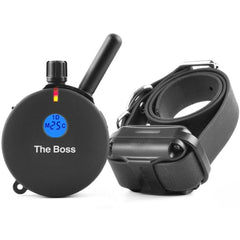How to Handle Negative Reactions to E-Collars on Your Dog

E-collars are like rising stars in the dog training world. While they've revolutionized the art of training dogs, they also face some glares amid the gazes.
Let's be real. These criticisms aren't just random glares. They stem from genuine concerns about animal welfare and misinformation fueled by irresponsible use.
However, let's also be fair. Dog training e-collars are communication tools. They're designed to solve dog behavioral problems, not harm your furry friends.
So, how do we navigate the stigma surrounding e-collar use? How do you respond to questions harboring negative views?
Read on to learn how to handle these types of discussions.
First Off, What Does an E-Collar Do?

An e-collar, also known as a dog shock collar, is a tool used in dog training, typically consisting of a dog collar and a remote transmitter. It's like a remote control that sends signals to your dog's collar. When you press a button, the collar may give a small beep, vibrate gently, or emit a mild sensation. The stimulation nudges your dog back on track, gently redirecting their attention and behavior.
Are Electronic Collars Safe for Dogs?
Electronic collars have been a topic of debate regarding their safety for dogs. The question remains: Are these tools safe for your beloved pets? The short answer is yes, but the whole story is more complicated. What does this mean?
It's essential to perceive e-collars as tools designed for training, not inherently harmful devices. Much like any tool in our lives, their effectiveness and safety heavily rely on how they are used.
Moreover, let’s not make a blanket statement that all dog e-collars are cruel and unsafe. While some models might not meet safety standards, high quality e-collars are also available in the market. Pet owners must be able to differentiate between poorly designed ecollar models and those that adhere to rigorous standards. Flimsy shock collars are usually cheaper, so that’s one thing to watch out for.
In her video, Steph Ferrari delves into the impact of e-collars with harsh settings, exposing how cheap collars can distort public perception.
PetsTEK’s Picks
For high-quality e-collars, check out these top recommendations:
1. Mini Educator ET-300 Remote Training Collar Yellow by E-Collar Technologies

The Mini Educator ET-300 is a crowd-favorite trusted by dog owners and trainers. With its sleek design and color options (yellow, black, and the Zen 300), it's as stylish as it is effective. It also comes with the innovative "Pavlovian Tone" training function, along with 100 levels of static stimulation and vibration.
2. Micro Educator ME-300 Remote Dog Training Collar Purple by E-Collar Technologies

The Micro Educator ME-300 is a compact dog training collar packed with advanced features. Enjoy the convenience of 100 levels of static stimulation, vibration, and tone options to cater to your dog's unique needs. With a range of 1/3 mile, it's perfect for close-range training sessions. Designed 20% smaller and lighter than the Mini Educator, this e collar is ideal for small dogs that require a gentler touch.
3. Boss Educator ET-800 Remote Dog Training Collar Black by E-Collar Technologies

The Boss Educator ET-800 is a remote dog training collar perfect for large, stubborn dogs. It has a 1-mile range, Pavlovian tone, and non-stimulating vibration. This e-collar is also expandable, allowing you to train two dogs simultaneously.
Addressing Misconceptions About E-Collars
There's a bunch of misinformation floating around, causing negative opinions about e-collars. To make sense of it all, it's important to figure out why these concerns exist in the first place:
-
Shock collars inflict pain on dogs.
One of the biggest concerns is the potential for pain inflicted by electrical stimulation. While the collars are designed to use minimal levels of stimulation, some argue that even mild shocks can be distressing to dogs.
Contrary to popular belief, the shocks delivered by e-collars are surprisingly weak. Philips Testing Service, a trusted electronics testing body, measured the energy of shock collars on low and high settings. Even in high settings, a bark collar emits a mere 0.0003 joules (300 microjoules), significantly lower than other electrical devices.
To put this into perspective, a low-level muscle stimulation machine packs 2000 times more punch (2.0 joules) than these training devices. At low levels, these training tools release a small amount of energy, like 0.000005 joules.
-
E-collar stimulation causes burns on the dog’s skin.
There's a common belief that the electric stimulation from shock collars might harm a dog's neck. But here's the real scoop: the static shock these e-collars give off isn't strong enough to cause burns, even at its strongest setting.
Those red marks some dogs get? Those are actually pressure sores, not burns. They happen because the contact points rub against the skin, not from any electric zap. And this can actually be avoided.

-
E-collars are punishment tools.
Many people have questions and concerns about e-collars, often stemming from the misconception that they're solely punishment tools. However, that's not the case. Proper e-collar training is actually built on positive reinforcement principles, with the stimulation playing a complementary role.
It's crucial to understand that these collars aren't meant for punishment but rather as aids in teaching good behaviors to dogs. The core objective is to link the stimulation with a specific command while the reward reinforces the correct behavior.
The collar stimulation is used as a cue for the dog, similar to how a clicker works. However, the unique advantage of an e-collar is its ability to communicate with your dog beyond audible cues.

How to Respond to People Reacting to E-Collars on Your Dog
Handling reactions to e-collars on your dog can be challenging due to the strong emotions it often stirs. Here are some suggestions to manage these situations calmly and effectively:
1. Be understanding.
When faced with skepticism or criticism about e-collars, showing understanding is key. Though e-collars prove beneficial in training, let's not entirely dismiss critiques. Some individuals might have had negative experiences with these tools, leading them to hold genuine concerns about using them.
These concerns can stem from a few factors, such as:
- Misunderstanding how to properly employ e-collars, which resulted in adverse outcomes for their dogs
- Encountering instances where e-collars were abused, leading to discomfort or distress for the dogs involved
Antonio Diaz, a balanced dog trainer, sheds light on why dog e-collars often receive a negative reputation due to misuse. He emphasizes that e-collars aren't miraculous fixes, contrary to mistaken beliefs held by some.
Being understanding doesn't mean you agree—it's about being open to different viewpoints and listening attentively. By learning from others and prioritizing responsible practices, e-collars can become a positive tool in the right hands.
2. Be prepared to explain.
Teaching others about using e-collars is a powerful way to clear up misunderstandings. It is crucial to give the correct details about why they're used, how to use them right, and their benefits. This helps debunk myths and wrong ideas that often make people see e-collars negatively.
- Bust myths: Address common misconceptions like "e-collars are cruel" or "e-collars burn your dog’s skin."
- Clarify proper usage: Emphasize the importance of professional guidance, low stimulation levels, and pairing e-collars with positive reinforcement training.
- Highlight benefits: Demonstrate the positive impact e-collars can have on specific training challenges. Mention how they helped your dog overcome recall issues, manage anxiety, or enjoy off-leash freedom.
Check out Tstarch's video showcasing how her dogs revel in off-leash freedom, thanks to remote dog training collars.
3. Be ready to walk away.
Not every interaction requires a full-fledged debate. Discern when a conversation can be productive and when it might be better to politely excuse yourself. Engaging with individuals who are demonstrably confrontational is unlikely to yield positive results and can only escalate the situation.
Bonus Tip
If you'd rather not have ecollar-related talks, consider covering the collar receiver when you’re training with your dog. A bandana or paracord e-collar strap can do the trick. This way, you can avoid unwanted attention or comments while training in public.

Final Word
Criticisms happen whether in dog training or life in general. As long as you're confident in your approach and not causing any harm, you don't need to worry about other people's opinions.
You might also enjoy...
-
Posted in
Dog Training, E-Collar Info & Guides, Training Tips


